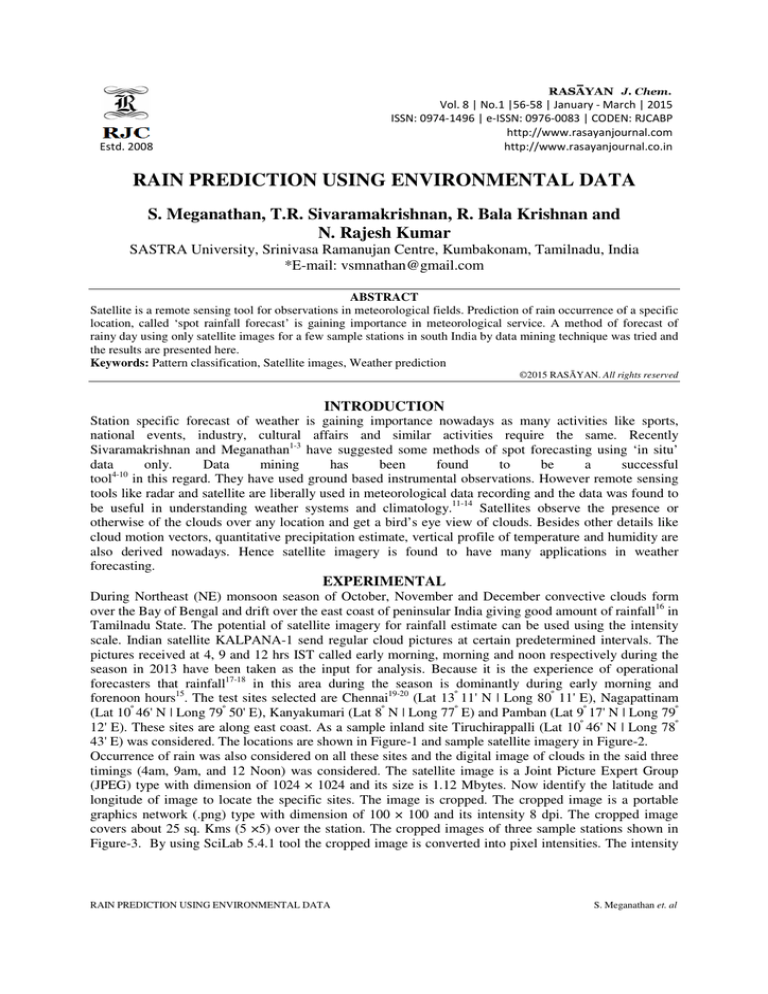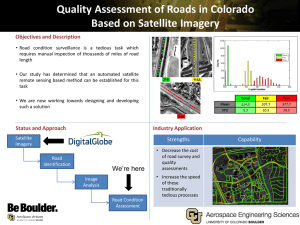
Vol. 8 | No.1 |56-58 | January - March | 2015
ISSN: 0974-1496 | e-ISSN: 0976-0083 | CODEN: RJCABP
http://www.rasayanjournal.com
http://www.rasayanjournal.co.in
Estd. 2008
RAIN PREDICTION USING ENVIRONMENTAL DATA
S. Meganathan, T.R. Sivaramakrishnan, R. Bala Krishnan and
N. Rajesh Kumar
SASTRA University, Srinivasa Ramanujan Centre, Kumbakonam, Tamilnadu, India
*E-mail: vsmnathan@gmail.com
ABSTRACT
Satellite is a remote sensing tool for observations in meteorological fields. Prediction of rain occurrence of a specific
location, called ‘spot rainfall forecast’ is gaining importance in meteorological service. A method of forecast of
rainy day using only satellite images for a few sample stations in south India by data mining technique was tried and
the results are presented here.
Keywords: Pattern classification, Satellite images, Weather prediction
©2015 RASĀYAN. All rights reserved
INTRODUCTION
Station specific forecast of weather is gaining importance nowadays as many activities like sports,
national events, industry, cultural affairs and similar activities require the same. Recently
Sivaramakrishnan and Meganathan1-3 have suggested some methods of spot forecasting using ‘in situ’
data
only.
Data
mining
has
been
found
to
be
a
successful
tool4-10 in this regard. They have used ground based instrumental observations. However remote sensing
tools like radar and satellite are liberally used in meteorological data recording and the data was found to
be useful in understanding weather systems and climatology.11-14 Satellites observe the presence or
otherwise of the clouds over any location and get a bird’s eye view of clouds. Besides other details like
cloud motion vectors, quantitative precipitation estimate, vertical profile of temperature and humidity are
also derived nowadays. Hence satellite imagery is found to have many applications in weather
forecasting.
EXPERIMENTAL
During Northeast (NE) monsoon season of October, November and December convective clouds form
over the Bay of Bengal and drift over the east coast of peninsular India giving good amount of rainfall16 in
Tamilnadu State. The potential of satellite imagery for rainfall estimate can be used using the intensity
scale. Indian satellite KALPANA-1 send regular cloud pictures at certain predetermined intervals. The
pictures received at 4, 9 and 12 hrs IST called early morning, morning and noon respectively during the
season in 2013 have been taken as the input for analysis. Because it is the experience of operational
forecasters that rainfall17-18 in this area during the season is dominantly during early morning and
forenoon hours15. The test sites selected are Chennai19-20 (Lat 13º 11' N | Long 80º 11' E), Nagapattinam
(Lat 10º 46' N | Long 79º 50' E), Kanyakumari (Lat 8º N | Long 77º E) and Pamban (Lat 9º 17' N | Long 79º
12' E). These sites are along east coast. As a sample inland site Tiruchirappalli (Lat 10º 46' N | Long 78º
43' E) was considered. The locations are shown in Figure-1 and sample satellite imagery in Figure-2.
Occurrence of rain was also considered on all these sites and the digital image of clouds in the said three
timings (4am, 9am, and 12 Noon) was considered. The satellite image is a Joint Picture Expert Group
(JPEG) type with dimension of 1024 × 1024 and its size is 1.12 Mbytes. Now identify the latitude and
longitude of image to locate the specific sites. The image is cropped. The cropped image is a portable
graphics network (.png) type with dimension of 100 × 100 and its intensity 8 dpi. The cropped image
covers about 25 sq. Kms (5 ×5) over the station. The cropped images of three sample stations shown in
Figure-3. By using SciLab 5.4.1 tool the cropped image is converted into pixel intensities. The intensity
RAIN PREDICTION USING ENVIRONMENTAL DATA
S. Meganathan et. al
Vol. 8 | No.1 |56-58 | January - March | 2015
value ranges from 0 to 255. Based on the threshold value the algorithm indicates the possibility of the
rainy day or non rainy day.
Fig.-1: Station locations under study
(a)Nagapattinam
Fig.-2. Input image from the satellite KALPANA-1
(b)Tiruchirappalli
(c)Pamban
Fig.-3: Cropped image for sample stations
Algorithm for rainy day prediction using Satellite Images (ARDPSI)
The proposed procedure for the rainy day prediction using satellite image finds the occurrence and nonoccurrence of the wet day with the parameters location, time and intensity values of the cropped image.
The proposed algorithm demonstrates the prediction techniques for pattern classification and weather
prediction. This mechanism identifies the source image from the “South India sector of satellite
KALPANA-1” and crop the image according to latitude and longitude. This operation identifies
circumstance of the local station around 25 square kms approximately. The algorithm for rainy day
prediction using satellite images (Figure- 4) finalizes the density parameter and compares the density
values of cropped image with density parameter to declare the occurrence of rainy day.
RESULTS AND DISCUSSION
After applying ARDPSI procedure the wet day (rainy day) and dry day (non rainy day) actually occurred
were compared with predicted wet and dry days. The results are shown in Table-1. It is seen that success
rate percentage is reasonably good. Compared to results using noon satellite imagery, prediction using
early morning and morning images are high. Prediction based on previous day’s imagery is also
satisfactory (60% or more).
CONCLUSION
The implementation offers a pattern classification image technique for rainy day prediction using satellite
images during October, November and December for this part of the country. The method is useful for
locations where there is no meteorological observatory. The point to note here is that the satellite imagery
is easily available in ‘internet’ and hence no investment towards collection of data or equipment is
needed. This methodology may work for regions where cloud formation and growth mechanisms are
similar.
RAIN PREDICTION USING ENVIRONMENTAL DATA
57
S. Meganathan et. al
Vol. 8 | No.1 |56-58 | January - March | 2015
Table-1: Success rate of wet / dry day prediction on Northeast monsoon
Wet / dry day prediction
Early
Morning
Noon
24 hour
24 hour
Station Name
Morning
(9 am)
(12 00)
Early
Morning
(4 am)
Morning
Chennai
72.22%
60.69%
59.98%
59.55%
59.25%
Kanyakumari
73.33%
75.61%
65.75%
71.91%
67.90%
Nagapattinam
75.56%
73.10%
64.38%
61.79%
66.67%
Pamban
67.78%
65.85%
64.01%
61.10%
62.96%
Trichy
77.17%
73.17%
68.49%
71.43%
65.43%
24 hour
Noon
63.01%
68.49%
63.01%
57.53%
70.27%
Input:
1.
2.
3.
4.
Satellite Image (SI)
Stations
Longitude and Latitude
Density Parameter (DP)
Output:
1. Predictive Occurrence (PO)
Algorithm
Step 1: Identify the Satellite Image SI.
Step 2: Apply the Longitude and Latitude on the SI to identify the station.
Step 3: Locate the station at deeper level around 5 square kms.
Step 4: Crop the SI with respect to the station.
Step 5: Generate the intensity values from the cropped image.
Step 6: Apply the DP on the intensity values to obtain the PO value.
Step 7: The PO value offers the predictive result that may either be a rainy or
Sunny day.
Fig.-4: Algorithm for Rainy Day Prediction using Satellite Images (ARDPSI)
REFERENCES
1.
2.
3.
4.
5.
6.
7.
8.
9.
10.
11.
12.
13.
14.
15.
16.
17.
18.
19.
20.
S. Meganathan, T.R. Sivaramakrishnan, Mausam., 66, 33(2015).
S. Meganathan, T.R. Sivaramakrishnan, Res. J. of App. Sci., Eng. and Tech., 5, 3692 (2013).
S. Meganathan, T.R. Sivaramakrishnan, J. of Theo. and App. Inf. Tech., 34, 173 (2011).
S. Meganathan, T.R. Sivaramakrishnan, Res. J. of App. Sci., Eng. and Tech., 35, 169 (2012).
T.R. Sivaramakrishnan, S. Meganathan, Archives Des Sciences., 65, 8 (2012).
T.R. Sivaramakrishnan, S. Meganathan, Res. J. of App. Sci., Eng. and Tech., 4, 1899 (2012).
B. Yubin Yanga, Hui Linb, Zhongyang Guob, Jixii Jiangc, Comp. & Geosciences., 33, 20 (2007).
C. Vaduva, D. Faur, Gavat I, 8th Int. Conf. On Comm., 5509002, 173 (2010).
Muhammad Shahbaz, Aziz Guergachi, Aneela Noreen, and Muhammad Shaheen, Proc. of the
World Cong. on Eng., 1, 406 (2012).
Chengjun Guo., Yunlong Teng, Lect. Not. In Com. Sci., 6677, 416 (2011).
S. Raghavan, T.R. Sivaramakrishnan, B. Ramakrishnan, J. Atmos. Sci., 40, 428 (1983).
T.R. Sivaramakrishnan, B. Ramakrishnan and V. Ramasamy, Mausam. 36, 120 (1985).
S.R. Kalsi, India Meteorological Department, (2002).
D.K. Mishra, S.R. Kalsi and R.K. Jain, Mausam. 39, 19 (1988).
T.R. Sivaramakrishnan, K. Prakasam, Vayumandal., 22, 116 (1992).
R. Varahasamy, Rasayan J.Chem., 7(3), 264 (2014).
M. Harish, Rasayan J.Chem., 3(4), 705 (2010).
A. Begum, S. Harikrishna and I. Khan, Rasayan J.Chem., 1(4), 856 (2008).
N.R. Prasad and J.M. Patil, Rasayan J.Chem., 1(4), 943 (2008).
N. Raman and D. Sathiyanarayanan, Rasayan J.Chem., 3(3), 539 (2010).
[RJC-1198/2015]
RAIN PREDICTION USING ENVIRONMENTAL DATA
58
S. Meganathan et. al


